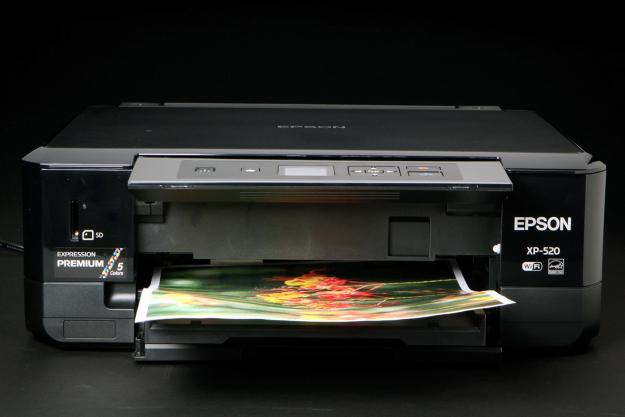
“As an affordable photo printer, Epson’s XP-520 is a good buy. As an MFP, however, it’ll make you wish you ponied up for more.”
- Duplexing
- Fast print speed for its price
- Excellent photo quality output
- No ADF
- Awkward, small paper tray
- Small LCD
The “premium” in Epson’s Expression Premium XP-520 ($130) might be a bit of a misnomer. As a printer, it delivers great quality output; photos look very good even on regular inkjet paper, making it a good value from that standpoint. But as a multifunction printer (MFP), there are enough quirks and missing features that you’ll be left wondering where the premium part is.
Features and design
Epson’s XP-520 is a fairly generic three-function all-in-one MFP. It can print, scan, and copy, but has no fax capability. Nor does it have the ability to print on CDs or DVDs with printable surfaces, as with some more expensive MFPs from Epson and others.
The XP-520 shares a similar appearance to its larger brother, the Expression Premium XP-820. In fact, both share the same footprint (overall measurements of the XP-520 is 15.4 × 13.4 × 5.4 inches), except the XP-820 is taller by 2.5 inches, thanks to the noticeable automatic document feeder (ADF). The XP-520 saves you $70, but you sacrifice the convenience an ADF affords. At 21.5 pounds, the XP-520 weighs the same as the XP-820, which is strange since it lacks the ADF.
While there’s no ADF, there is a scanner platen on top, beneath the cover. A front control panel has a tiny 1.4-inch LCD that’s simply impossible to read, although it displays icons nice and large. The LCD isn’t touch capable, so you’ll need to use the navigation buttons to scroll through menus.
The XP-520 suffers from the same paper tray problem as the XP-820, and we think Epson’s designers should rethink this feature for the next batch of printers. The tray is located at the front bottom of the device, and it’s difficult to access. You must first push in the output tray to get it out of the way, in order to reach the paper input tray; you then need to pull the out tray back into place. It’s just not convenient. Also, Epson rates the tray capacity at 100 sheets, but it’s almost impossible to actually get this much paper in the tray.
The XP-520 suffers from the same poorly designed paper tray as other Epson printers.
We also experienced a problem with the follower in the tray that sets the length of the paper. When we set the follower to letter size, the pressure of placing the paper in the tray pushed the follower back to the A4 setting, which kept the paper from feeding reliably. Another annoying thing: Whenever the tray is removed and replaced, a message comes up on the LCD asking you to verify the paper type — but since you generally have to set the paper size and type in the print driver, we found this unnecessarily frustrating.
On the plus side, the XP-520 has an abundance of connectivity options suitable for home use. While it lacks a wired Ethernet port, there’s USB, Wi-Fi, and Wi-Fi Direct (which does not require a router or access point). To the left of the control panel is a slot for flash memory cards (SD, SDHC, SDXC, and Memory Stick Duo), which you can use to print directly from a card or scan directly to one, without needing a PC. The printer can also scan directly to the cloud or print from several cloud services when it’s connected to the Internet. It’s compatible with Google Cloud Print, Apple AirPrint, and Epson’s own Epson Connect.
You can also print several standard forms such as lined paper and calendars directly from the printer without it being connected to a PC.

The XP-520 uses Epson’s Claria inks, but being that it’s a photo printer, it adds a photo black to the standard mix of CMYK. This allows the printer to produce more subtle shades of gray and darker blacks, and is used only when the print driver is set for photo printing. Normally, the photo black ink is not used for non-photo documents.
The standard (273) and higher capacity (273XL) ink cartridges have fairly good yields. The standard tanks yield 273 pages in color and 300 in black; the standard black cartridge yields 300 pages, while the photo black tank can print as many as 200 4×6 photos. Each cartridge costs about $13.
The higher capacity cartridges cost $19 (except for the black cartridge, which costs $23), and yields 650 pages for the color inks, 500 for the black, and about 400 4×6 photos for photo black.
What’s in the box
There’s not much packed in the box besides the XP-520. A power cord is included, as is a startup poster and a CD that contains print and scanner drivers for Windows (XP to 8) and Mac OS X (10.6 to 10.10). Also included are five starter ink cartridges.

Warranty
Epson provides a limited one-year warranty, but extended service plans are available. Click here for details.
Setup and performance
Setting up the XP-520 is simple: Plug it in, insert the ink tanks, and let them prime for a bit – about five minutes. While the machine does its thing, you can install the software and drivers from the included CD. If you know your way around computers, bypass the CD and just locate drivers from the Internet. Once it’s ready to go, you can go through the menus to connect the unit to the Internet.
In both our speed and print quality tests, the XP-520 performed quite well.
In our speed test, the XP-520 did quite well. Epson rates the device as printing 9 pages per minute (ppm) in color and 9.5 ppm in black and white. Our speed test, which consists of printing a four-page document of mostly text, achieved an average print speed of just over 12 ppm.
For our image quality test, we printed three test images using two of Epson’s papers — Premium Photo Paper Glossy and Presentation Matte — and Hammermill Premium Inkjet and Laser Paper. Output on the two Epson papers was outstanding for a five-color printer – highly saturated, bright, and with accurate coloring. However, we were nicely surprised with the results on Hammermill paper, which at $12 is about twice as expensive as standard multipurpose paper. Again, colors were accurate, and while saturation suffered a bit (as it almost always does on standard papers) the overall output quality was very suitable for a school or business report with images or graphics.
The scanner has an optical resolution of up to 2,400 dpi, and produced scans that were accurate in color and features. Copying worked fine, but as with so many inkjet-based MFPs, it was like watching grass grow.
Conclusion
Our feelings about Epson’s XP-520 are conflicted. It’s a step-up from the sub-$100 printers you sometimes find in supermarkets. It has great photo quality output, with the photo black ink providing razor-sharp blacks. But it also has some quirks and lack of features that we feel impact its day-to-day use (these include having to pull out the output tray after powering on the unit or loading the paper, having to verify the paper type each time the paper tray is replaced, a small LCD, and having no ADF on the scanner).
For many home users, these are minor annoyances. If you can live without the aforementioned features, the XP-520 will reward you with great image quality – great if you’re looking for an affordable photo printer. (Although the printer is still new, look for possible price drops in a few months.)
But if you are looking for a workhorse MFP that you’ll use all the features on daily, we suggest you spend a bit more and get yourself the Brother MFC-J4420DW, Canon Pixma MG7520, or even Epson’s Expression Premium 820. When it comes to value, it really depends on which side you sit on.
Highs
- Duplexing
- Fast print speed for its price
- Excellent photo quality output
Lows
- No ADF
- Awkward, small paper tray
- Small LCD






